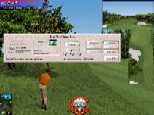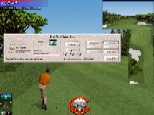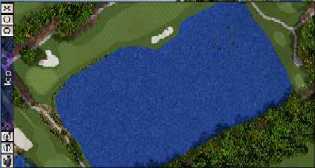
| The definitive Links magazine | 07 Nov 1999 |
| MAIN PAGE | WHEN
THE WIND BLOWS (Part 1)
I'd like to bet that when you first played Links the conditions you chose were N/N/M - or perhaps B/N/M. How many rounds did you play with these 'standard' conditions before moving onto more exotic combinations? How long before you tried Windy conditions? And after you first tried them, did you then quickly go back to playing all those practice rounds in various combinations of breezy - only playing Windy when forced to through one of those internet tournament sites that you'd just discovered? The above scenario certainly applied to me in the early days of my Links career. I found playing in Windy conditions hard work. My idea of a relaxing practice round didn't involve having my slices off the tee being picked up by a howling crosswind and dumped into the wild grass at Prairie Dunes or Plantation. When I started playing internet tournaments (we're talking a few years back now), I invariably found that I had to play a windy round or two. Such rounds would inevitably lead to an undignified slide down the leaderboard. Even when I actually got quite good at the game, my lack of practice and understanding of windy conditions held me back. Anyone who's played for a reasonable length of time on Case's Ladder will know that very few players - especially at Pro level - will choose windy conditions for a match. The few ladder players that would choose windy conditions generally fall into one of two categories: 1) Good players that enjoy
windy conditions and know how to play them.
Some players even seem to regard the selection of windy conditions as being somewhat rude. Select windy conditions and they immediately get sulky - and then a few holes later you're 3up and they've given up already. Some people do like windy conditions. In fact some people love them. These LS studs turn their noses up at breezy conditions, and wouldn't be seen dead playing in no-wind conditions, where any golf match becomes merely a 'snapping contest'. When there's any debate on the sort of conditions being generated for tournaments these 'studs' are always eager to proclaim their Links machismo. Such people may or may not have a point, but they do have an advantage. The advantage is confidence. This is the key factor in playing well in windy conditions. If you step out onto the course scared of being blown all over the place then that's almost certainly what will happen. Of course, you do have to be aware of the physical effect the wind will have on the ball, but not letting the conditions intimidate you is a good start. Let's look at some specifics… Course management is particularly important in windy conditions. It's the combination of the wind and certain green conditions that can dictate how to approach a hole. Kapalua Bay offers lots of good examples of this. K Bay is a course that, under most conditions, offers lots of opportunities for good scoring. However, played under windy conditions, with soft greens, the course becomes a rather trickier proposition. Let's look at the first hole. A nice straightforward reachable par 5 - normally. Played under windy conditions with soft greens - with the wind against - you need to approach the hole with a little more thought. The usual combination of driver off the tee followed by a 3w will leave you 50 to 60 yards short of the green. Prime position for a birdie? Not under these conditions! Try hitting a wedge into the green and the backspin will take the ball back to the front fringe 4 times out of 5. This is not likely to lead to birdie. An approach more likely to lead to a four would be to hit a long iron second shot, leaving 130 to 140 yards for your third shot - probably requiring a 5 iron into the wind. Now under these conditions, you will still get backspin hitting into the green with a 5 iron, but it will be significantly less than with a wedge and gives you more chance of staying close to the hole. An argument against would be that from that distance a missed snap would put you further from the hole. Not necessarily. Remember that if we'd used a wedge and ended up on the front fringe we could be some 20 yards from the hole. A missed snap with a 5 iron (provided you don't miss by a big margin) won't necessarily put us in any worse a position. An even more novel approach
to this situation would involve hitting a 3w second shot, but actually
aiming to putt the ball into the rough! Hitting from the rough kills backspin,
and also the ball will travel a little further into the wind from a rough
lie than from the fairway. Provided you know how to judge shots from the
rough, and are reasonably confident of your snap, this can be a really
good option in this situation.
Playing into the wind, several of the par 5's at K Bay will play this way, and indeed so will almost any of the normally reachable par 5s on any course. Playing wedge shots to soft greens into the wind is generally a bad idea. Hitting off the tee also
requires more thought when playing in windy conditions. One common error
people make is in aiming. The average tee shot goes 275 to 280 yards. With
a tailwind that goes up to 315, with a headwind it goes down to 235ish.
Depending on the hole layout, just hitting at the normal aiming spot might
put you in trouble. A classic example of this is to be found at Pinehurst
8 - on the 14th hole.
A normal aiming spot in calm conditions- for the more confident among us, - might be where the fairway starts to narrow. Alternatively - and for the more cautious - using a 3w and aiming further back down the fairway might be a safer option. If the wind blows however, both these options become bad news. With a headwind, both would leave us in the water, and with a tailwind we'd be in the rough. In a headwind situation, the first thought might be to hit a driver over the middle of the bunker. The problem with this is that with the slightest of hooks into a headwind - especially on champ mode - you'll be in the drink. With a tailwind you could try to hit a driver with a draw to the narrow fairway. If you snap the shot it'll be great, but again a missed snap could leave you in a great deal of bother. With a headwind, the percentage shot would be to aim to the right of the bunker with a Driver. With a wind behind, a 2I is sufficient - also aimed to the right of the bunker. In either case, even with slight missed snaps your ball should at least stay dry. With a wind behind it's always tempting to let rip with a driver. A word of caution though. On course like Prairie Dunes and Troon North, where fairways can narrow past the normal driving distance, and wild grass lurks not so far away, a missed snap on the teeshot can leave you playing three from the tee. In such cases it may be worthwhile hitting a 2i. With the wind behind you will get good distance, and it's a much safer shot. With a tailwind, missing the fairway from the tee can leave you at a greater disadvantage than with a headwind. The reason being that hitting out of the rough with a gale behind makes it virtually impossible to stop your ball near the pin - or on the green for that matter. Perversely, with a headwind it can actually be advantageous to hit your approach from the rough - as we've seen in the example above at Kapalua Bay. The key thing to remember in all these situations is that what matters is finding the best place to hit your approach shot from. And that may or may not be the farthest spot down the fairway - or even on the fairway at all! Simon Courcha Part 2 to follow soon... |


